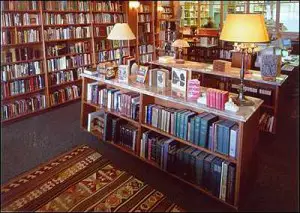 I live within driving distance of the world’s largest new and used bookstore, Powell’s City of Books. Located in downtown Portland, Oregon, the store occupies an entire city block and stocks more than a million new and used books. While Toronto may boast the largest bookstore in the world, as a collector, only Powell’s could occupy a special place in my heart. It is still everything I thought Disneyland would be when I was four.
I live within driving distance of the world’s largest new and used bookstore, Powell’s City of Books. Located in downtown Portland, Oregon, the store occupies an entire city block and stocks more than a million new and used books. While Toronto may boast the largest bookstore in the world, as a collector, only Powell’s could occupy a special place in my heart. It is still everything I thought Disneyland would be when I was four.
Which is why I hardly needed an excuse to spend a day perusing their aisles when researching the most common misconceptions about book collecting. As I often get lost there as the store map compromises its functionality for artistic integrity, I asked a mousy attendant about rare books. Initially, she leaned over the massive kiosk the size of a regular bookstore, and directed me toward the two towering stacks designated “book collecting.” But after I clarified my needs, I received directions to the rare book room two floors above. Then, I fought my way past the hoards of buyers, through five or six color-coded regions, and a few rooms before I arrived at the heavy door of the temperature controlled room.
There would be time to visit the food court, I mean, coffee shop, later.
If any individual fields questions about rare books from the public, I realized it must be Ben Hunter, the Rare Book Specialist at Powell’s. Indeed, he graciously shared the three most common misconceptions he heard regarding rare books: 100 Years is Old Logically, no one can argue with this assumption considering the average human lifespan, but logic won’t raise a book’s value for a collector. After the invention of the printing press in 1440, the mass production of books became a simple feat. Scribes no longer penned each letter laboriously. And that resulted in many books, old or new becoming common. Books hold value based on their desirability to collectors, not their age.
Think about it. A rock can be both quite old and still un-valuable whereas gems are rare and highly prized.
Condition, Condition, Condition The correlation between the condition of the manuscript and their appeal to a collector cannot be overemphasized. Non-collectors understand this premise more quickly when applied to similar collectables such as stamps and coins rather than books.
But for books printed after 1900, dust jackets matter significantly. Many sellers will evaluate the condition of the book separately from the dust jacket, because collectors care.
Rare Books Are…Rare Though it may seem implicit, the public often confuses the interest collectors have in rare books. Just as age does not make a book valuable, neither does infamy. Scarcity alone drives value in book collecting.
While very few may have heard of the first book written by a well-known author or the book may have even been a disappointment to the author’s grammar instructor, the combination of its scarcity and notability trumps its otherwise undesirable characteristics.
Whether you buy and sell books or just enjoy book collecting, you’ve probably held these misconceptions or fielded inquires from the public who do still. Powell’s Book Store supplies a “frequently asked questions” printout in their rare books room free for the public. In addition to answering questions customers may be too shy to ask, it supplies information that may encourage an interested customer to becoming a new and informed collector. And you don’t need to be the world’s biggest shop either or hire a cartoon guide in a full body costume to help them pass this hurdle into becoming a collector.
Carrie Bailey has appreciated book collecting since damaging a valuable copy of The Wizard of Oz as a child. She writes YA and promotes new writers on her blog Peevish Penman. Currently pursuing her Master’s in Information Studies, she enjoys working as a librarian, but dislikes barcodes.

Excellent post. I often use the example of an old violin, explaining to people that just because it’s been in Grandpa’s attic since the 1800s, that doesn’t make it valuable if it was a cheap instrument to begin with, and unless it’s been taken care of over the years it’s probably in pretty rough shape. Strad? Many copies, few originals. Rare. Thanks, Carrie.
You are welcome. I think the violin is a great example, but also even a cheap violin with historical significance can become valuable, which is possibly what leads to people’s confusion.
I agree! Seen too many eager eyed sellers of falling apart Religious Tract Society children’s books that were Sunday School Prizes of Great Grandma.
Having to explain that even though they are 120 years old they are just as dull as when they were written can be pretty difficult.
You’re comment certainly made me smile. I think people forget the part about how someone has to want them and if they don’t value their great-grandma’s childhood prize who would?
There is a difference between “Rare” and “Scarce”. The definitions I heard in comparison of the two is,
Rare: there are few copy’s and many people want them.
Scarce: there are few copies and few (if anyone) wants them.
I’ve found times where I list a book as ‘rare’ and later changed it to scarce…
That’s an important distinction to make certainly.
I am considering buying a plane ticket to the US just to visit that bookshop. I didn’t know places like that existed. Dream. Come. True.